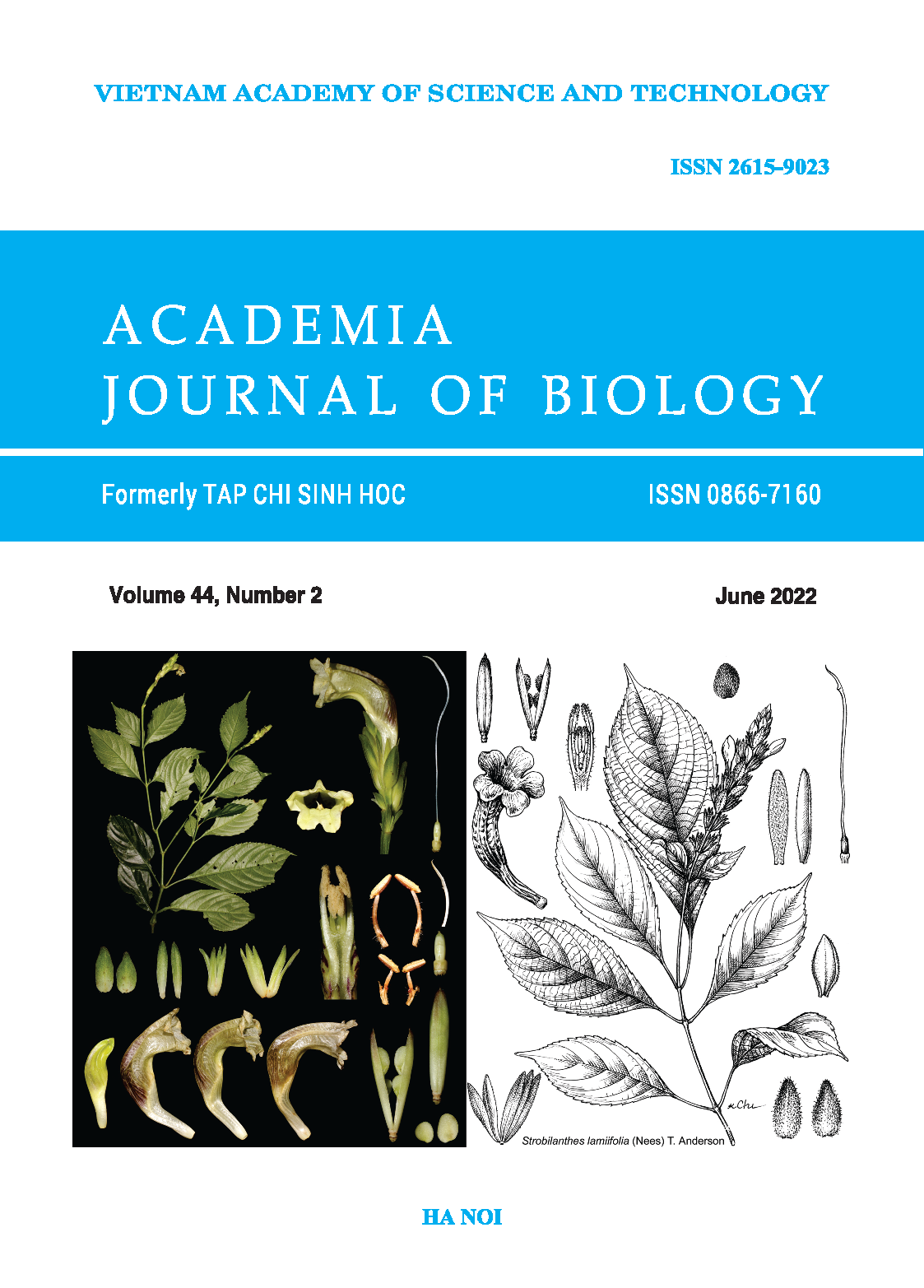Complete human mtDNA genome sequences revealed haplotype features of the Hmong-Mien language family in Vietnam
Authors
DOI: https://doi.org/10.15625/2615-9023/17115Keywords:
Dao, Hmong, Pathen, mtDNAReferences
Bandelt H. J., Forster P. and Rohl A., 1999. Median-joining networks for inferring intraspecific phylogenies. Molecular Biology and Evolution, 16(1): 37−48. https://doi.org/10.1093/oxfordjournals.molbev.a026036
Brucato N., Mazières S., Guitard E., Giscard P. H., Bois É., Larrouy G. and Dugoujon J. M., 2012. The Hmong Diaspora: Preserved South-East Asian genetic ancestry in French Guianese Asians. Comptes Rendus Biologies, 335(10−11): 698−707. https://doi.org/10.1016/j.crvi. 2012.10.003
CIA, Vietnam, in The World Factbook, 2022. Central Intelligence Agency.
Duong N. T., Macholdt E., Ton N. D., Arias L., Schröder R., Van Phong N., Thi Bich Thuy V., Ha N. H., Thi Thu Hue H., Thi Xuan N., Thi Phuong Oanh K., Hien L. T. T., Hoang N. H., Pakendorf B., Stoneking M. and Van Hai N., 2018. Complete human mtDNA genome sequences from Vietnam and the phylogeography of Mainland Southeast Asia. Scientific Reports, 8(1): 11651. https://doi.org/ 10.1038/s41598-018-29989-0
Eberhard D. M. F., Simons C. D., 2021 G. F., S.l.: Sil International, global (Ethnologue: languages of asia).
Excoffier L. and Lischer H. E. L., 2010. Arlequin suite ver 3.5: a new series of programs to perform population genetics analyses under Linux and Windows. Molecular Ecology Resources, 10(3): 564−567. https://doi.org/10.1111/j.1755-0998.2010.02847.x
Hill C., Soares P., Mormina M., Macaulay V., Clarke D., Blumbach P. B., Vizuete-Forster M., Forster P., Bulbeck D., Oppenheimer S. and Richards M., 2007. A Mitochondrial Stratigraphy for Island Southeast Asia. The American Journal of Human Genetics, 80(1): 29−43. https://doi.org/10.1086/510412
Hill C., Soares P., Mormina M., Macaulay V., Meehan W., Blackburn J., Clarke D., Raja J. M., Ismail P., Bulbeck D., Oppenheimer S. and Richards M., 2006. Phylogeography and ethnogenesis of aboriginal Southeast Asians. Molecular Biology and Evolution, 23(12): 2480−2491. https://doi.org/10.1093/ molbev/msl124
Ko A. M. S., Chen C. Y., Fu Q., Delfin F., Li M., Chiu H. L., Stoneking M. and Ko Y. C., 2014. Early Austronesians: Into and Out Of Taiwan. The American Journal of Human Genetics, 94(3): 426−436. https://doi.org/10.1016/j.ajhg.2014.02.003
Kutanan W., Kampuansai J., Srikummool M., Kangwanpong D., Ghirotto S., Brunelli A. and Stoneking M., 2017. Complete mitochondrial genomes of Thai and Lao populations indicate an ancient origin of Austroasiatic groups and demic diffusion in the spread of Tai–Kadai languages. Human Genetics, 136(1): 85−98. https://doi.org/10.1007/s00439-016-1742-y
Kutanan W., Shoocongdej R., Srikummool M., Hübner A., Suttipai T., Srithawong S., Kampuansai J. and Stoneking M., 2020. Cultural variation impacts paternal and maternal genetic lineages of the Hmong-Mien and Sino-Tibetan groups from Thailand. European Journal of Human Genetics, 28(11): 1563−1579. https://doi.org/10.1038/s41431-020-0693-x
Le C., Ren Z., Zhang H., Wang Q., Yang M., Liu Y., Huang J. and Wang J., 2019. The mitochondrial DNA control region sequences from the Chinese Miao population of southeastern China. Annals of Human Biology, 46(7-8): 606-609. https://doi.org/10.1080/03014460.2019.1694701
Li H., Cai X., Winograd-Cort E. R., Wen B., Cheng X., Qin Z., Liu W., Liu Y., Pan S., Qian J., Tan C. C. and Jin L., 2007. Mitochondrial DNA diversity and population differentiation in southern East Asia. American Journal of Physical Anthropology, 134(4): 481−488. https://doi.org/10.1002/ajpa.20690
Liu D., Duong N. T., Ton N. D., Van Phong N., Pakendorf B., Van Hai N. and Stoneking M., 2020. Extensive Ethnolinguistic Diversity in Vietnam Reflects Multiple Sources of Genetic Diversity. Molecular Biology and Evolution, 37(9): 2503-2519. https://doi.org/10.1093/molbev/msaa099.
Maricic T., Whitten M. and Pääbo S., 2010. Multiplexed DNA Sequence Capture of Mitochondrial Genomes Using PCR Products. PLoS ONE, 5(11): e14004. https://doi.org/10.1371/journal.pone.0014004
Mortensen D. R., 2017. Hmong-Mien Languages, in Oxford Research Encyclopedia of Linguistics., Oxford University Press.
Nei M., 1987 Molecular Evolutionary Genetics. Columbia University Press.
Palanichamy M. G., Sun C., Agrawal S., Bandelt H. J., Kong Q. P., Khan F., Wang C. Y., Chaudhuri T. K., Palla V. and Zhang Y. P., 2004. Phylogeny of Mitochondrial DNA Macrohaplogroup N in India, Based on Complete Sequencing: Implications for the Peopling of South Asia. The American Journal of Human Genetics, 75(6): 966−978. https://doi.org/ 10.1086/425871
Ratliff M., 2021. 14 Classification and historical overview of Hmong-Mien languages. The Languages and Linguistics of Mainland Southeast Asia: A comprehensive guide, 8, pp. 247. https://doi.org/10.1515/9783110558142
Schurr T. G. and Wallace D. C., 2002. Mitochondrial DNA Diversity in Southeast Asian Populations. Human Biology, 74(3): 431−452. https://doi.org/ 10.1353/hub.2002.0034
Taguchi Y., 2021 Historiography of Hmong-Mien linguistics, in The Languages and Linguistics of Mainland Southeast Asia, P. Sidwell and M. Jenny, Editors, De Gruyter. pp. 139−148.
Tanaka M., Cabrera V. M., González A. M., Larruga J. M., Takeyasu T., Fuku N., Guo L. J., Hirose R., Fujita Y., Kurata M., Shinoda K. I., Umetsu K., Yamada Y., Oshida Y., Sato Y., Hattori N., Mizuno Y., Arai Y., Hirose N., Ohta S., Ogawa O., Tanaka Y., Kawamori R., Shamoto-Nagai M., Maruyama W., Shimokata H., Suzuki R. and Shimodaira H., 2004.
Mitochondrial genome variation in eastern Asia and the peopling of Japan. Genome Research, 14(10A): 1832−1850. https://doi.org/10.1101/gr.2286304
Wen B., Li H., Gao S., Mao X., Gao Y., Li F., Zhang F., He Y., Dong Y., Zhang Y., Huang W., Jin J., Xiao C., Lu D., Chakraborty R., Su B., Deka R. and Jin L., 2005. Genetic Structure of Hmong-Mien Speaking Populations in East Asia as Revealed by mtDNA Lineages. Molecular Biology and Evolution, 22(3): 725−734. https://doi.org/10.1093/molbev/ msi055
Xia Z. Y., Yan S., Wang C. C., Zheng H. X., Zhang F., Liu Y. C., Yu G., Yu B. X., Shu L. L. and Jin L., 2019. Inland-coastal bifurcation of southern East Asians revealed by Hmong-Mien genomic history. bioRxiv, 730903. https://doi.org/10.1101/730903
Downloads
Metrics
Downloads
PDF Downloaded: 188





